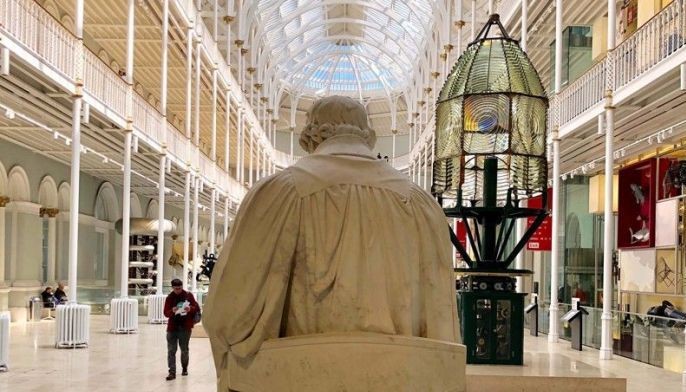As unlikely as it may seem, many Filipino writers have a special affinity for Scotland, that northern country (yes, it is one) bound up into the United Kingdom with England, Wales, and Northern Ireland. That’s not only because of our passing familiarity with the likes of Robert Burns and Walter Scott, but because, over the past three decades, more than a dozen Filipino writers—among them Krip Yuson, Eric Gamalinda, Ricky de Ungria, Marj Evasco, Rofel Brion, Danton Remoto, Mia Gonzalez, and myself—have been fellows at the Hawthornden Castle International Retreat for Writers, about half an hour by bus in Midlothian, just outside of Edinburgh.
That was where, in 1994, I wrote much of what became Penmanship and Other Stories, including the title story, which came out of a serendipitous purchase of a 1938 Parker Vacumatic at the Thistle Pen Shop in Edinburgh. Indeed, two literary anthologies have emerged from the Pinoy-Scottish connection: Luna Caledonia, a poetry collection edited by Ricky de Ungria and published in 1992, and Latitude, a fiction collection co-edited by Sarge Lacuesta and Toni Davidson and published in 2005.
I returned to Scotland in 2000 with my wife Beng and daughter Demi in tow; I was a writing fellow then at the University of East Anglia in Norwich, and Demi was visiting us from Manila. As it happened, a local radio station was offering free train tickets to Scotland to whoever could dial in and answer some simple questions at 5 a. m., so for three consecutive mornings, I woke up early and did just that, and soon we three were rolling away to Glasgow, taking the scenic route along the western coast (and being feted on the train by a kindly Pinoy attendant).
That was 20 years ago, and since then Beng and I have expressed a more than idle longing to revisit Scotland—especially Beng, an unabashed fan of Braveheart and Outlander. In the meantime, Demi got married to bright young fellow from California named Jerry, and in 2014 Demi and Jerry treated us, on our 40th wedding anniversary, to a tour of Spain, following Rizal’s footsteps in Madrid and Barcelona, and Anthony Bourdain’s in San Sebastian.
We wanted to repeat that this year to mark our 45th, so it was no huge surprise that we settled on Scotland where Jerry—who likes his single malts—had never been. After meeting up in London, we took a train to Edinburgh and lodged in the shadow of its imposing castle, to which we paid the obligatory visit. I treated our small party next to a day tour of Stirling Castle, Loch Lomond, Deanston Distillery, and Doune Castle, before moving on the next day to Glasgow and its more down-to-earth, industrial vibe.
The Scottish countryside from the ramparts of Stirling Castle.
I wanted to record this not to bore you with the details of another family sortie, but to remark on what impressed us most, outside of the often desolate beauty of the Scottish highlands and our comic encounters with the “hairy coos” (the Highland cattle probably fattened by tourist feedings).
For me, a retired professor who can’t help being interested in a country’s educational and cultural infrastructure, the question was, how could the Scots have done so much with seemingly so little?
Pop stars like Sean Connery, Arthur Conan Doyle, Robert Louis Stevenson, JK Rowling, and Annie Lennox aside, Scotland has produced engineer James Watt, inventor Alexander Graham Bell, penicillin discoverer Alexander Fleming, social philosopher Adam Smith, and explorer David Livingstone. A book by the historian Arthur Herman titled How the Scots Invented the Modern World asks: “Who formed the first literate society? Who invented our modern ideas of democracy and free market capitalism? The Scots…. In the eighteenth and nineteenth centuries Scotland made crucial contributions to science, philosophy, literature, education, medicine, commerce, and politics—contributions that have formed and nurtured the modern West ever since…. John Knox and the Church of Scotland laid the foundation for our modern idea of democracy; the Scottish Enlightenment helped to inspire both the American Revolution and the U.S. Constitution; and thousands of Scottish immigrants left their homes to create the American frontier, the Australian outback, and the British Empire in India and Hong Kong.”
This from a country of less than six million people (that’s right, six), whose influence extends far beyond their shores. While wives and widows everywhere may bemoan the loss of their husbands to golf and whisky, both industries annually contribute £1 billion and £6 billion, respectively—about P500 billion combined—to the Scottish economy, which is also driven by oil and gas, a £12-billion industry. (To put things in perspective, you can add up those three for a total contribution of £19 billion or about US$25 billion, which is what Philippine BPOs generate, as well as OFWs—but with a much smaller denominator.)
What was most telling to me was how Scotland, despite its plethora of warriors, politicians, engineers, and industrialists, valued its writers, who in turn valued Scottish national pride. The 200-foot statue of Walter Scott in Edinburgh is the largest in the world of any writer’s, and in Glasgow, Scott’s monument also towers over those of others in George Square.
Of course we can argue that we venerate Jose Rizal—only to elect his moral opposites. As the Scots might put it, “A nod’s as guid as a wink tae a blind horse.”
* * *
Email me at jose@dalisay.ph and visit my blog at www.penmanila.ph.


